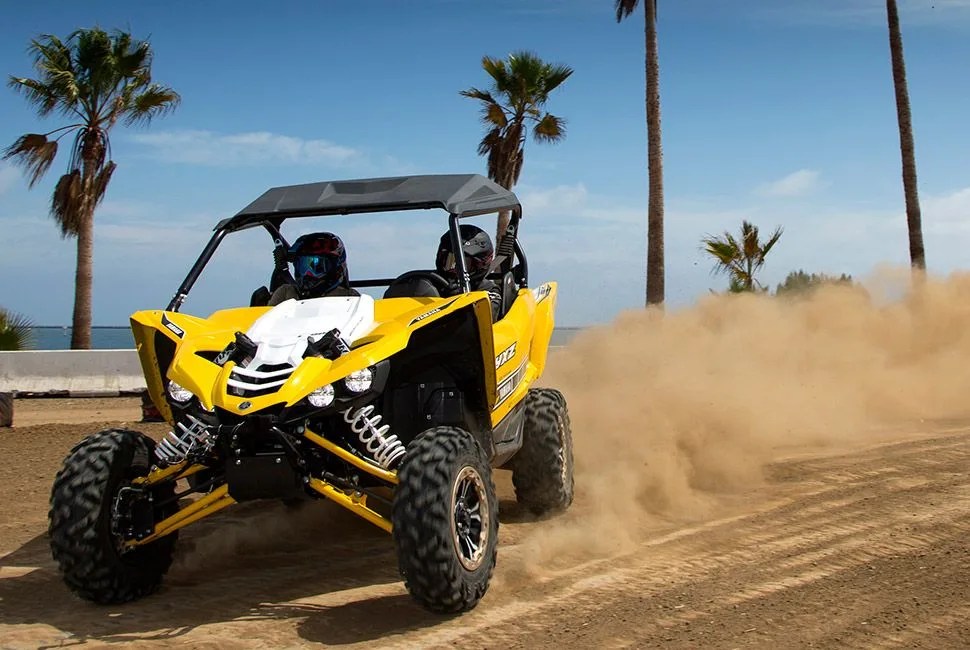It was like the YXZ1000R launched by way of the viral marketing handbook — artful teaser videos were released in the months prior, but showed frustratingly little in the way of detail. Leaked photos were circulated around off-road forums and were dissected to exhaustion; some wondered if it was Yamaha themselves doing the leaking. Any shred of confirmed info was kept top secret from press and consumers alike until promptly at 10:00 a.m. on September 1 — at which point the off-road enthusiasts watching Yamaha’s livestream managed to crash the website. Clearly, Yamaha felt the launch of the YXZ1000R was important enough in the off-roading world that it didn’t need to give any advanced looks or exclusives.
To see the SxS in person required a secretive journey by sea. I boarded a boat in Long Beach Harbor, destination still unknown, and motored away. Two hours and a few area codes later, I was welcomed ashore at the Port of Los Angeles by post-apocalyptic, Mad Max scenery that would have made George Miller blush. An asphalt parking lot had been spruced up with truckloads of dirt into a track of whoops and jumps. Corrugated metal was repurposed into rustic, rusting motorcycle grunge, surrounding an illuminated screen. Once the smoke from the pyrotechnics cleared and the bass-heavy soundtrack echoed away, a powerful, one-of-a-kind SxS was left in the wake.
Once the smoke from the pyrotechnics cleared and the bass-heavy soundtrack echoed away, a powerful, one-of-a-kind SxS was left in the wake.
The Yamaha YXZ1000R ($19,799) is a 1,500-pound beast anchored by a 998cc, three-cylinder engine and a five-speed manual transmission. It’s heavily influenced by the Japanese automaker’s theory of “humachine” — the idea that the vehicle’s design should foster an intimate connection with the driver. The manual shift and foot-actuated clutch are the first of their kind in an SxS, meaning the ride in the YXZ1000R is more an extension of the driver than anything else on the market. Shifting requires attention, and this machine wants all of yours.
Riding in the YXZ1000R, the features that separate it from the market are instantly noticeable — the body style is influenced by trophy trucks and dune buggies, while the engine is that of a supercharged motorcycle. The three cylinders and 10,500 RPM redline means power is entirely at your disposal, and the YXZ1000R begs to be pushed to its limit. The sequential shifter eliminates the learning curve of the typical H-tree, making accelerating simple and intuitive. It quickly climbs from a rolling start to 60 mph in fourth gear, then slides smoothly down to third and into second for sweeping turns. On corners, the machine grips the dirt with intention and security, then leaps back up to speed on command. The suspension is long and forgiving — Fox RC2 Podium shocks exposed on the front of the vehicle dare the driver to be aggressive. And, most important for some, the YXZ1000R handles jumps with ease. It quickly leads one to imagine weekends lost out on the dunes.
Yamaha calls the YXZ1000R “category-defining,” which is fair enough. The sport side-by-side market is still undiscovered for many. People are used to seeing the rugged, utilitarian models like the Rhino and Polaris Ranger around ranches and construction sites, but the race-ready model can be confounding. Over the course of the day, I hear it classified as a machine, a vehicle, a unit, a utility vehicle and an SxS. The term “side-by-side” hasn’t made it into most people’s everyday vernacular, and it seems to connote something weaker, with less teeth than the YXZ1000R. Maybe this identity crisis is why it took Yamaha six years to enter into the market, well after Polaris’ RZR had proven itself viable. The YXZ1000R waited to make a definitive statement.
Though the RZR and Can-Am’s Maverick were first into this nascent market of off-road vehicles, they may no longer be best. With the YXZ1000R, Yamaha has made a roaring machine that targets hardcore drivers who view their vehicle as a sentient companion. But more than that, they have created a side-by-side important enough to warrant understanding by a wider audience. Yamaha’s newest “humachine” may be the one to take this category to the public spotlight, and if so, it’ll be sure to do it with appropriate flare — pyrotechnics, heavy bass and plenty of speed.
